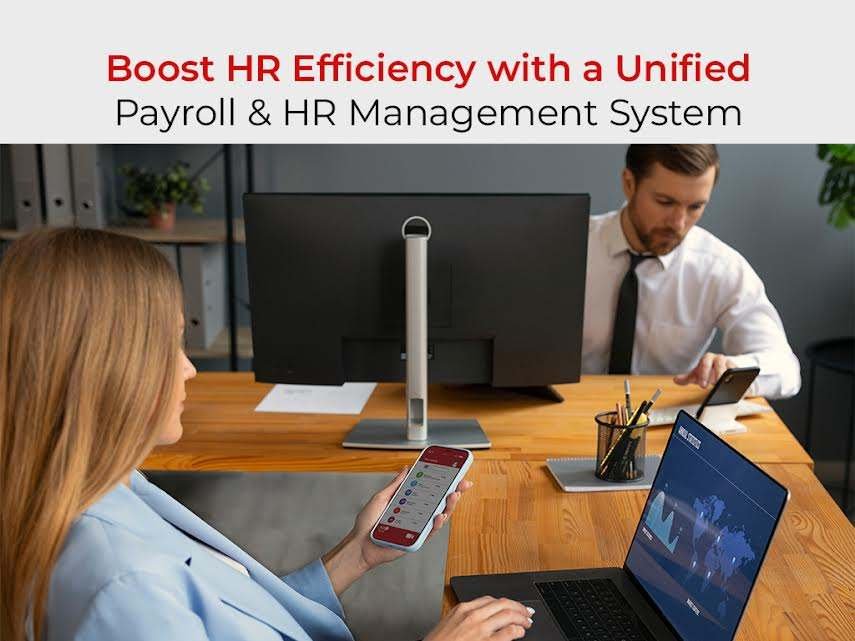In today’s fast-paced business environment, HR departments are under constant pressure to streamline operations, reduce costs, and enhance employee satisfaction. A critical step towards achieving these goals is the implementation of a unified payroll and HR management system. This integrated solution can revolutionize the way HR functions, offering significant benefits in terms of efficiency, accuracy, and strategic decision-making.
The Challenges of Traditional HR and Payroll Management
Traditionally, HR and payroll have been managed as separate functions, often using disparate systems. This siloed approach leads to several challenges:
Manual Data Entry Errors: Inconsistencies between HR and payroll data can result in errors, delays, and compliance issues.
Time-Consuming Processes: Manual payroll calculations, time-off requests, and employee data updates are time-consuming and prone to human error.
Lack of Visibility: Without a unified system, it’s difficult to get a comprehensive view of the workforce, making it challenging to make informed decisions.
Compliance Risks: Staying updated with ever-changing labour laws and regulations can be complex without a centralized system.
The Power of Integration: A Unified Solution
A unified payroll and HR management system addresses these challenges by bringing together all HR-related data and processes into a single platform. This integration offers numerous advantages:
Enhanced Efficiency: Automation of routine tasks such as payroll processing, time and attendance tracking, and employee self-service significantly reduces manual effort and frees up HR staff to focus on strategic initiatives.
Improved Accuracy: By eliminating manual data entry and ensuring data consistency across the system, the risk of errors is minimized.
Better Decision Making: With access to real-time data and analytics, HR leaders can make informed decisions about workforce planning, compensation, and performance management.
Enhanced Compliance: The system can be configured to adhere to labour laws and regulations, reducing the risk of penalties and legal issues.
Improved Employee Experience: Employees can access their pay stubs, personal information, and time-off requests through a self-service portal, improving their overall experience.
Key Features of a Unified System
A comprehensive payroll and HR management system should include the following core features:
Core HR Management: Employee information, organizational structure, job descriptions, and performance management.
Payroll Processing: Salary calculations, tax deductions, benefits administration, and direct deposit.
Time and Attendance: Time tracking, leave management and overtime calculations.
Benefits Administration: Enrollment, eligibility, and claims management for various benefits.
Talent Acquisition: Applicant tracking, job postings, and onboarding.
Reporting and Analytics: Customizable reports for HR metrics, payroll data, and workforce analytics.
Self-Service Portal: Employee access to personal information, pay stubs, time-off requests, and benefits.
Selecting the Right System
Choosing the right unified payroll and HR management system is crucial for the success of your implementation. Consider the following factors:
Scalability: Ensure the system can accommodate your organization’s growth.
Customization: The system should be flexible enough to adapt to your specific business needs.
Integration Capabilities: Evaluate the system’s ability to integrate with other HR systems and applications.
Security and Compliance: Verify that the system meets data security and privacy industry standards.
Cost: Consider the total cost of ownership, including implementation, licensing, and maintenance.
Enhanced Employee Satisfaction and Engagement
A unified payroll and HR management system can significantly boost employee satisfaction and engagement. By providing employees with a self-service portal, they can easily access their pay stubs, personal information, and benefits. This empowers employees to take control of their HR-related matters, reducing the burden on HR staff and improving overall employee experience. Additionally, the system can facilitate personalized benefits packages, tailored to individual employee needs and preferences. By offering a comprehensive and user-friendly experience, organizations can foster a positive work environment and increase employee retention.
Data-Driven Decision Making
One of the most significant benefits of a unified system is the ability to harness data for informed decision-making. HR metrics such as turnover rates, time-to-hire, and employee satisfaction can be tracked and analyzed to identify trends and areas for improvement. Payroll data can provide insights into labour costs, overtime expenses, and compensation trends. By leveraging this data, HR leaders can make data-driven decisions about workforce planning, talent acquisition, compensation strategies, and overall HR initiatives. For example, analyzing turnover rates can help identify departments with high turnover and pinpoint potential causes, such as lack of training or career development opportunities.
Mitigating Risks and Ensuring Compliance
A unified payroll and HR management system can help organizations mitigate risks and ensure compliance with labour laws and regulations. The system can automate tasks such as tax calculations, deductions, and reporting, reducing the risk of errors and penalties. Additionally, it can provide alerts and reminders for compliance deadlines, helping HR teams stay up-to-date with changing regulations. By centralizing employee data and automating processes, organizations can streamline audits and demonstrate compliance to regulatory bodies.
Conclusion
Investing in a unified payroll and HR management system is a strategic decision that can significantly improve your organization’s efficiency, accuracy, and overall HR performance. This integrated solution empowers HR teams to focus on driving business growth and enhancing employee satisfaction by streamlining processes, reducing errors, and providing valuable insights.


